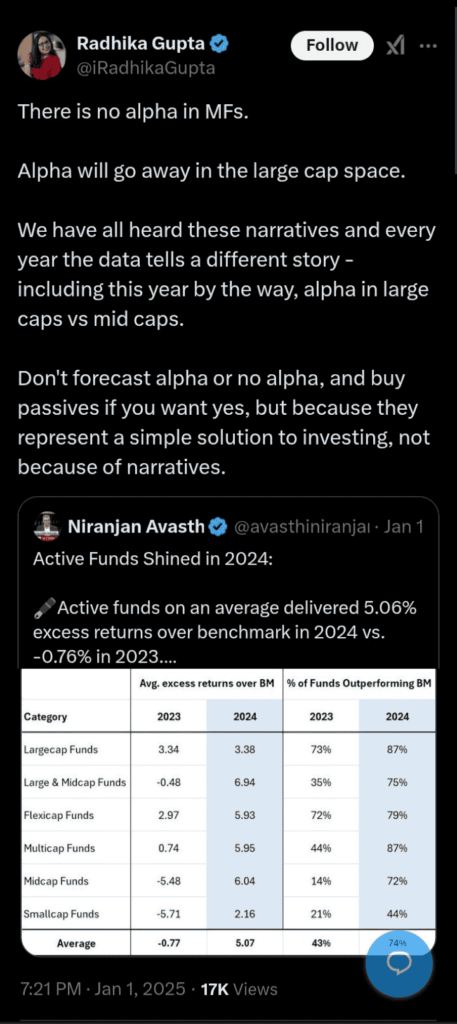Radhika Gupta’s Insights on Alpha in Mutual Funds:”Don’t forecast alpha or no alpha, and buy passives if you want yes”

Quick Overview of CEO of Edelweiss Mutual Fund Radhika Gupta’s statment on X, Jan 1, 2025
Radhika Gupta, CEO of Edelweiss Mutual Fund, has made a significant statement regarding the concept of alpha in mutual funds, particularly in the large-cap segment. She argues that the expectation of alpha—excess returns above a benchmark—will likely diminish, urging investors to focus on the simplicity of passive investments rather than the narratives surrounding active fund performance.
Key Points
- Diminishing Alpha in Large-Cap Funds: Gupta believes that alpha will decrease in large-cap mutual funds, suggesting a shift in investment strategy.
- Performance Variation: Active funds showed strong performance in 2024, outperforming benchmarks, but Gupta emphasizes that this performance varies year to year.
- Blend of Active and Passive Strategies: Niranjan Avasthi, Senior Vice President of Edelweiss, advocates for a balanced approach, blending both active and passive investments to adapt to market changes.
- Recent Performance Data: In 2024, active funds delivered an average excess return of 5.06% over benchmarks, with mid-cap funds notably rebounding.
- Market Trends: The second half of 2024 saw significant sector rotations, highlighting the effectiveness of active management during fluctuating market conditions.
Radhika Gupta posted on X formaly Twitter on jan 1, 2025:
“There is no alpha in MFs.
Alpha will disappear in the large cap space.
We’ve all heard these stories, and each year the data tells a different tale, including this year’s alpha in large caps vs. mid caps. Don’t foresee alpha or no alpha, and if you want to buy passives, do so because they represent a simple solution to investing, not because of tales.”

Detailed Breakdown
Diminishing Alpha
Gupta’s assertion that alpha will fade, especially in large-cap funds, is based on the evolving nature of market dynamics. She encourages investors not to get caught up in forecasting alpha, as the narratives surrounding mutual funds often change yearly. Instead, she suggests using passive funds for their straightforward investment approach.
Performance Insights
Niranjan Avasthi’s comments provide context to Gupta’s views. He pointed out that active funds had a remarkable year in 2024, with an average excess return of 5.06% over their benchmarks, compared to a negative return in the previous year. Notably, mid-cap and large & mid-cap funds led the pack, achieving excess returns of 6.94% and 6.04%, respectively. This highlights the potential for active management to outperform in certain market conditions.
The Case for Blending Strategies
Avasthi emphasizes the importance of blending active and passive strategies in investment portfolios. He notes that while active investing may outperform in some years, passive strategies can take the lead in others. This flexible approach allows investors to adjust their strategies based on market conditions rather than adhering strictly to one method.
Market Dynamics
The latter half of 2024 experienced significant sector and factor rotations, which active management helped navigate effectively. This adaptability is crucial in a constantly changing market landscape, reinforcing the idea that a one-size-fits-all approach to investing may not be the best strategy.
Performance Data and Outperformance Rates of Mutual Funds in 2024 & 2023
- Performance Data: In 2024, large & mid-cap funds achieved an excess return of approximately 6.94%, while mid-cap funds achieved 6.04%. Small-cap funds, although lagging with a 2.16% excess return, still showed improvement from -5.71% in 2023.
- Outperformance Rates: Approximately 44% of small-cap funds outperformed their benchmarks in 2024, a significant increase from 21% in 2023, indicating a recovery in this sector.
In Conclusions
Radhika Gupta’s perspective on the future of alpha in mutual funds encourages a reevaluation of investment strategies, particularly in the large-cap space. The fluctuating performance of active funds underscores the importance of flexibility in investment approaches. By blending active and passive strategies, investors can better navigate the complexities of the market, adapting to changes as they arise. Ultimately, Gupta’s advice serves as a reminder that simplicity in investing can often lead to more effective outcomes.